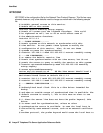
Installing and Configuring RSYNC
Issue 1 July 2006 59
This file defines the two/three directories to be synchronized between the two servers. Note that
this only defines the operation of RSYNC and what symbolic names are available, it does not
perform any actual synchronization.
RSYNCHOURLY.SH
RSYNC must be executed with suitable parameters to perform synchronization. The sample
shell script that follows directs a single synchronization process. CRON can also use the script
on an hourly basis to ensure that both servers are synchronized regularly.
rsync -qruW 10.0.0.1::MV_IPTel_data/ /opt/ecs/mvuser/MV_IPTel/data/
FTPdata
rsync -qruW 10.0.0.1::MV_IPTel_TFTPdata/ /opt/ecs/mvuser/MV_IPTel/
data/TFTPdata
Optional:
rsync -qruW 10.0.0.1::MV_IPTel_HTTPdata/ /opt/ecs/mvuser/MV_IPTel/
data/HTTPdata
Copy
this file to “/etc/cron.hourly”. Restart the CRON daemon to regularly execute the job.
This file is NOT the same for both servers. The IP address at the start of the parameters is the
source of files on the remote server, and so will be the “other” server for both servers. To clarify
this, server A must have server B’s IP address and vice-versa. The remaining arguments define
the RSYNC symbolic name on the “other” machine and the local file structure to be used as a
target for RSYNC.
Network Time Protocol
Although Network Time Protocol (NTP) is not an essential component of the High Availability
server cluster, NTP allows the two servers to have identical times. Having identical times helps
when analyzing log files and prevents problems with the RSYNC process.
The Network Time Protocol Daemon (NTPD) is installed as standard for Linux, but is not usually
enabled. After suitable configuration, enable and configure the NTPD service to start
automatically following a Linux restart.


















